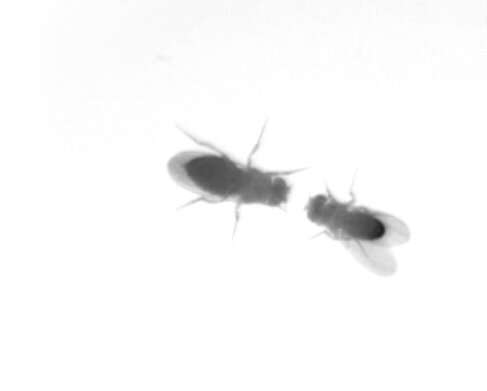Detailed behavioural analysis reveals how the progression from courtship to copulation happens in the fruit fly. Credit: Maria Luisa Vasconcelos and Cecilia Mezzera, Champalimaud Centre for the Unknown.
On a hot summer day, in a darkened chamber, a video camera follows a couple as it engages in nature's oldest game—courtship. The male sings and chases after the female when suddenly a long tubular organ emerges from her rear end. The male recoils at first, but then returns to investigate. Is this a sign that the female is interested in moving on to the next phase, or should he try his luck elsewhere?
For many years, fruit fly investigators have been engaged in a passionate debate over the answer to this question. Various reports implicated the sudden emergence of this organ, called ovipositor, in both sexual rejection and acceptance. Now, researchers at the Champalimaud Centre for the Unknown in Portugal, discovered that the ovipositor plays a crucial role in the transition from courtship to copulation. Their results were published today (August 13th) in the scientific journal Current Biology.
The Secret to Successful Foreplay (If you're a Fruit Fly)
Fruit-fly sexual behavior might bring to mind famous sci-fi films, like "Transformers." "During courtship, the female pushes her vaginal plates backwards. This movement causes them to spread and form the ovipositor—a temporary tube-like structure protruding from the tip of the abdomen. This is the same organ by which fruit flies, and other insects, lay eggs," explains Maria Luisa Vasconcelos, one of the lead co-authors of the study.
What is the role of the ovipositor in sexual behavior? "There are contradictory reports," says lead co-author Cecilia Mezzera. "While some say that it blocks and repels the male, others believe that it actually predicts copulation."
To find the source of these conflicting studies, the team combined detailed video-monitoring of the flies' behavior with advanced genetic tools. "We identified a particular pair of neurons in the brain of the female fruit fly that commands the extrusion of the ovipositor. We then activated or silenced these neurons and studied the effect of these manipulations on the flies' behavior," Mezzera explains.
With this two pronged approach, the team found the answer. "It is known that courtship begins with the male singing to the female, which he does by vibrating his wings. We observed that the female responds to the song by extruding her ovipositor," Vasconcelos recounts. "Now comes the missing piece. All this while, the male repeatedly licks the female genitalia. We discovered that it is the coincidence of ovipositor extrusion and licking that stimulates the male to attempt mating."
In or out?
"But a copulation attempt is not a sure success," adds Mezzera. "Our detailed behavioral monitoring revealed that the ovipositor is not a binary organ, which is either in or out. Instead, it can be extruded to different degrees."
The team found that the female entices the male to attempt mating by exhibiting her full ovipositor. But then, she can either keep the ovipositor fully out, or transition into a partial extrusion. As it turns out, this is the real deal-breaker. "Here, the results split depending on whether the female fly has mated recently and is therefore unreceptive, or if it's a receptive virgin. We discovered that even though both types of females extrude their ovipositor, only the virgins partially retract it to allow mating," says Vasconcelos.
Why would unreceptive females engage in behaviors that encourage courtship? The authors speculate that there are two possibilities. "The first is remating. For a few hours after mating, and given the appropriate context, mated females will eject the sperm and remate. This way, they may be able to increase the number of offspring and their genetic diversity. The second explanation is that the ovipositor may carry the female's pheromones. These odor molecules may inform the male that the female has already mated. Then, depending on the combination and intensity of the chemical cues, the male may or may not initiate courtship."
At the end of the day, it's all about the brain
Together, the team's findings reveal a sequence of steps in the male-female communication that resolves the contradictory reports of classical studies. "Our results shed light on how the transition from courtship to copulation happens. This is key to studying how such a dramatic behavioral switch—from the appetitive to the consummatory stage of sexual behavior—is processed in the brain. The more we learn about how this works, the closer we get to answering the big question we are all pursuing—how the brain generates behavior," Mezzera concludes.
More information: Cecilia Mezzera et al. Ovipositor Extrusion Promotes the Transition from Courtship to Copulation and Signals Female Acceptance in Drosophila melanogaster, Current Biology (2020). DOI: 10.1016/j.cub.2020.06.071
Journal information: Current Biology
Provided by Champalimaud Centre for the Unknown
























